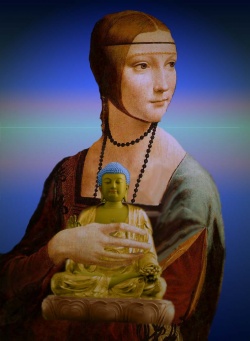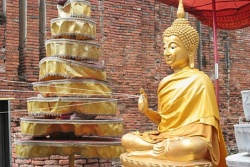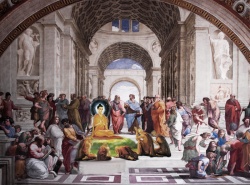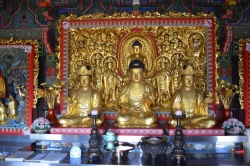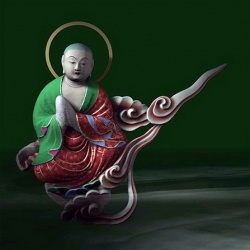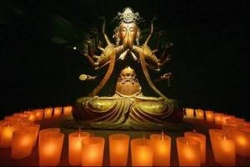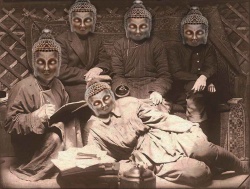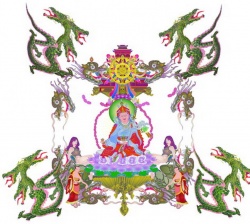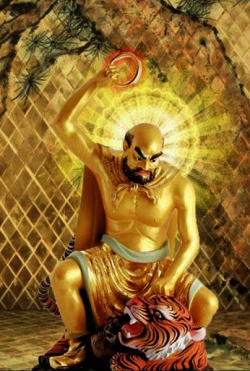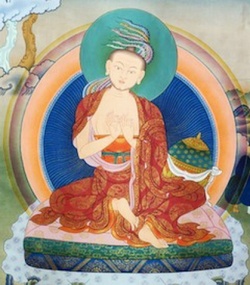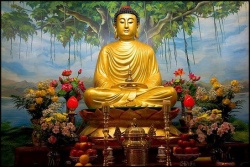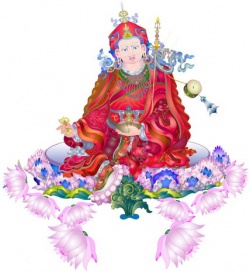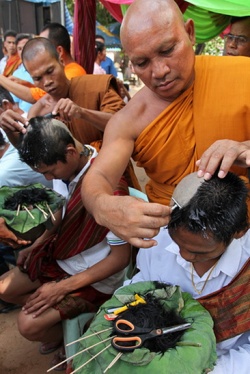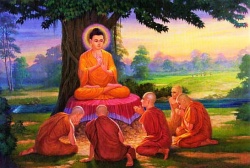The Eight-petalled Lotus Flower pattern in Sanskrit figurative poetry.
The eight-petalled lotus flower pattern in Sanskrit figurative poetry.
A study1 Hermina Cielas, Jagiellonian University, Kraków
SUMMARY: Nowadays the lotus flower has the status of the ‘national plant’ of India. through the ages it became a very well known symbol characteristic of literature and visual arts of the area. he significance of the lotus in the culture of South Asia and related territories is indisputable. In order to gather some insight into the role of this symbol in literature, it is necessary to refer to mythology, religious traditions and iconography. In the case of figurative poetry, which will be the main focus of interest in the current article, it is impossible not to take into consideration the multiple denotation of the symbol used to create a pictorial stanza. therefore, the present study is divided into two main parts: the first one provides a brief introduction to the significance of the lotus flower in Indian culture, and the second one discusses the lotus pattern in Sanskrit figurative poetry according to Agnipurāṇa and Bhoja’s Sarasvatīkaṇṭhābharaṇa.
1. Symbol of the lotus in Indian culture
The symbolism of the lotus flower in Indian culture is such a broad topic and so much has been said about it that it is impossible to carry out a detailed study of it in the introductory part of this article. For this reason, the following part contains only selected references discussing the most important aspects of it and showing its antiquity.
he symbol2 of the lotus lower can be found already in the oldest works of Indian literature. Nowadays in Indian culture it is undoubtedly a symbol 1 I would like to thank Prof. Lidia Sudyka for valuable comments, suggestions and assistance.
2 As Jan Gonda points out, for the lotus “the term symbolism is not correct, because the ancient Indians (…) did not look on a lotus flower as a mere outward sign of a principle or a divine ‘concept’; for them it was a visible representation, the very embodiment of the divine itself.” On the other hand, David Smith claims that this is “to overestimate the flower’s divinity and underestimate its symbolism” (Smith 2000, p. 212.) and I would like to support this view.
of creation. But where can we ind the source of this view? In the Ṛgveda the lotus or its parts are mentioned eight times.
3 It appears also in Nirukta where it is a irmament, a platform of existence, because puṣkaram antarikṣam poṣati bhūtāny – “a lotus, space between heaven and earth nourishes beings”.
4 the echo of this view can also be found in the Vedic ritual where the lotus plays an important role.5
Later on, the symbol gains a new meaning. In Indian cosmogony the lotus lower is a symbol of the world (bhūpadma, lokapadma, pṛthivīkamala), where the loral receptacle corresponds to Mount Meru (which according to Indian mythology is in the center of the world and symbolizes axis mundi). A lot of information about the role of the lotus lower in Indian cosmogony can be found in the purāṇas. According to those texts the world-lotus’ receptacle is placed in the centre of jambudvīpa since, as Ludo Rocher says, “a number of texts represent the Earth in the form of a lotus with Mount Meru in the center as the pericarp of the lotus and just four continents around it as its petals”.6 he lotus as a support of the universe, the Earth lying on cosmic waters, is also mentioned in the taittirīya Sȧhitā (Garzilli 2000, p. 78).
he lower is related to many gods of the Hindu pantheon too. It is a symbol of Brahmā, but it is also very oten attributed to Sūrya – Sun, who 3 ṚV V.78.7., ṚV X.107.10., ṚV X.184.2., ṚV VII.33.11., ṚV VI.16.13., ṚV III.58.7., ṚV VI.62.4., ṚV VI.67.10. According to Sāyaṇa púṣkarād ádhi appearing in hymn VI.16.13 means puṣkaraparṇe – on a lotus leaf. Such an interpretation, as Grazilli indicates, may have its source in the shape of the lotus leaf, which is a little bit sunken (in the case of leaves emerging above the surface of the water) and could it the poetic vision of Agni’s cradle/first seat. But as she says, “the image of a lotus flower can it that purpose” as well. Thomas Kintaert (2009, p. 2) says that the original meaning of the puṣkara in the hymn is debatable, although, “we do have instances of the term puṣkara relating to a lotus leaf ”. In Sanskrit figurative poetry there is no doubt that the lotus pattern means always the shape of a flower. More on the lotus in Ṛgveda, cf. Garzilli 2003. 4 Nirukta
.14. All the translations quoted in the article are mine unless otherwise stated. 5 Further information about the meaning of the lotus flower in the ritual can be found in Staal 1983 and Garzilli 2003.
6 Among those texts we can ind the matsyapurāṇa which in chapters 164–171 describes the story of the origin of the world from a lotus flower (Rocher 1986, p. 97). A similar vision of the word as a lotus flower can be found in the Bhāgavatapurāṇa (Babkiewicz 2012). For more about Indian cosmography, see Sircar 1967. The eight-petalled lotus flower pattern in [[Sanskrit figurative poetry 75 is called the Lord of the Lotus (Ward 1952, p. 136) and in the later period mostly to the goddess Padmā – the personification of the cosmic lotus which gave birth to all creatures. In the Ṛgveda we can already ind two names for her known from classical literature – Śrī and Lakṣmī (Zimmer 1972, p. 91). But the Lotus Goddess has many different names, mostly related to her main attribute – a lotus flower. She is called padmasȧbhavā “lotus- born”, padmākṣī “lotus-eyed”, padmesthitā “standing on a lotus” etc.7 In this way, along with a deity the plant became a symbol of the Goddess and of the Earth (because Padmā is called the highest form of the Earth as well). A lot has also been said about the motif of the Lotus Goddess in Buddhist art and religion,8 where it has the significant meaning of purity because although a lotus grows in mud, its blossoms are raised on its stalk above the water’s surface (Ward 1952, p. 137). thanks to this feature, a lotus which is pure can be compared to a pious devotee born in a dirty world. The lotus symbol as the dominant one among lowers, representing “rising above the muddy flood of daily life” is also prominent in kāvya literature and very popular with early poets (Smith 2000, p. 217). Later on, Padmā’s major attribute became a symbol of the female creative power of male gods – śakti (Ward 1952, p. 137).
he lotus symbol can also be found in the Tantric tradition (in Hindu, Buddhist and Jaina Tantras), where its meaning is mostly esoteric. Generally, the lotus flower indicates a heart representing the highest state of consciousness that can be realized. In the Trika school of Kashmiri Śaivism the heart-lotus is a well-known symbolic figure, sometimes identified with Śiva; the Supreme Consciousness itself. he lotus symbol plays an important role in the religious practice of Tantric traditions too. Both in Hindu and Buddhist Tantras, maṇḍalas in the shape of lotus flowers are used for 7 Ward 1952, p. 138. here are not only a lot of names for the Lotus Goddess, but also many synonyms of the term padma – lotus in Sanskrit. Probably it was also influenced by the requirements of the metre in poetry. Moreover, Yigal Bronner (2010, pp. 128–9) points out, that expanding the meaning of words and creating new synonyms can also be the result of deliberate action in the formation of lexicographical works. Bronner connects this phenomenon to the frequent occurrence of śleṣa in Sanskrit literature. For more information about the lotus synonyms, see Wilhelm Rau’s article, where the author lists 101 names for the lotus in kāvya literature (Rau 1954). 8 More on the lotus in Buddhist art and religion, cf. Ward 1952 and Garzilli 2003. 76
meditation.
One should concentrate on the maṇḍala, visualizing a specific god or goddess. Moreover, according to the Jaina text tattvārthasāradīpikā, there is a meditation on the lotuses of the body – six energetic points known from the medical literature, each located one above the other, synonymous with cakras – placed in the human body and used for mystical or chiromantic purposes. his kind of meditation starts with imagining and concentrating on the ocean, in the middle of which there is a great lotus of jambudvīpa (Garzilli 2003, p. 80). he most important role is played here by the visual form of the lotus flower, containing a particular meaning which becomes a basis for the ritual. In the same way, as we will see, figurative poetry uses the symbolism of the lotus contained in the lower pattern. It is beyond the scope of the present article to discuss in detail the significance of this symbol and devote as much attention to it, as it deserves. It can be hoped however, that the above-mentioned data at least show indisputably that the lotus symbol is very popular in Indian culture and has many different aspects. To understand fully its denotation in literature we have to be aware of all of these meanings and try to choose the most suitable interpretation.
2. The lotus pattern in citrakāvya
he diversity of symbols and points of view perpetuated in culture constitute its richness. It is very clear also in Sanskrit figurative poetry, citrakāvya, where the presence and significance of various symbols is directly related to semiotics, which helps us discover a sense hidden in the visual.The main assumption of such poetry is a fusion between word (śabda), its meaning (artha) and image (citra) and other elements of the poem, such as the rhythm or the meter. Citrakāvya has entertaining and educational purposes. To notice the graphic side (a special, typographical arrangement of letters and words creating an image) of the poem (which is not indicated directly as in the case of the European concept of carmina figurata), a reader has to have particular knowledge or needs the help of a guru – a teacher. Every image (citra) used to create a pictorial stanza (especially in the case of citrabandha – images of a well-known item just like a lotus flower) he eight-petalled lotus flower pattern in Sanskrit figurative poetry 77 as a graphic sign conveys meaning with symbolic value and has its own denotation. In Sanskrit, elements of figurative poetry were used to emphasize certain content. To read such a poem fully we have to pay an attention to all the domains of language included; otherwise, the final aesthetic experience will not be complete.
2.1. Agnipurāṇa
he Agnipurāṇa is probably the only work which calls citrakāvya a kind of poetry. In the 342nd chapter of this purāṇic text we can ind detailed information about figurative poetry – its definition, classification and instructions concerning how to compose a pictorial stanza. Among the bandha (“pattern, construction”: Monier-Williams 2005, p. 720.3) a lotus flower pattern is listed as one of the so-called duṣkara, “hard to create” (Monier- Williams 2005, p. 487.3). It is given a few names: ambuja, saroruha, saroja and sarasīruha in the text, but there is no doubt that it is the shape of the flower, not of the leaf, since its petals are mentioned. (Agnipurāṇa instructs us how to create three types of ambujabandha – with four, eight and sixteen petals, but gives no examples. Further, it lists the requirements of the meter. According to the text, lotus pattern stanzas should be composed in anuṣṭubh metre.11
2.2. Bhoja and Ᾱnandavardhana’s Devīśataka lotus
Detailed information and an elaborated division of citrakāvya are given by Bhoja (ca. 11th century). In his work, Sarasvatīkaṇṭhābharaṇa he divides 9 Agnipurāṇa is one of the main 18 purāṇic texts. he AP is an encyclopedic work, where we can ind information about astronomy and astrology, rites, architecture, art, law, medicine, poetics, grammar, etc. Because it is a compilation, it is hard to say to which age it belongs. Ludo Rocher provides a few attempts at dating Agnipurāṇa inter alia S.K.De’s opinion that “the poetic section is later than the middle of the ninth century” and Haraprasad Shastri’s who suggests 800–900 AD (Rocher 1986, p. 136). Agnipurāṇa is mentioned by Alberuni, an Arabic traveler from the early 11th century, and was compiled probably ca. 8th–9th century.
10 ambuja – AP VII.31., VII.41., sarasīruha – AP VII.36., saroruha – AP VII.40., saroja – AP VII.42. and abjaka in cakrābjaka, “lotus-wheel pattern” – AP VII.32. and VII.50. 11 AP VII.57: dvitīyam cakraśārdūlavikrīḍitakasampadam | gomūtrikā sarvavṛttair anye bandhāstvanuṣṭubhā ||
citra into six varieties. Lotus lower patterns are listed among ākāracitras (“pictures of a figure”) along with cakra – wheel patterns. Although Bhoja does not provide such a systematization, we can roughly divide the lotus patterns given by him into two categories: plain ones and those which contain a poet’s name. Among the former are a few varieties: lowers with four, eight and sixteen petals. he main focus of our interest is the second kind, which has three types. he first one its the instructions given by Agnipurāṇa. he stanza given by Bhoja, as an example, is taken from Ᾱnandavardhana’s Devīśataka:13
yāśritā pāvanatayā yātanācchid anīcayā |
yācanīyā dhiyā māyāyāmāyāsā̇ stutā śriyā || To whom one resorts for her ability to purify; who is a destroyer of our torments; who should be praised by an [[enlightened mind(anīcayā) as a defense (āyāsā) against the efforts of Māyā; who is praised by Śrī. (Trans. Daniel H.H. Ingalls) As has been pointed out before, the stanza is created according to rules for the construction of the eight-petalled lotus flower pattern given by the Agnipurāṇa.
As we can read in the treatise:
12 SKBh 2.284–2.295. It is a form of innovation characteristic of Bhoja since Agnipurāṇa and also other texts list lotus patterns as bandha. Among ākāracitras listed by Bhoja only lotus and wheel patterns can be found.
13 Ibid. 2.284., Devīśataka 4. Ᾱnandavardhana (ca. 9th century) is credited with creating a dhvani (‘resonance, sound, aesthetic suggestion’) theory. He was an author of the Dhvanyāloka. In his work, he expressed his unlattering opinion about citrakāvya where he refers to citra as “diferent than both kinds of poetry” (kāvye ubhe tato’ nyad yat tac citram abhidhīyate – Dh 3.41cd.).
This is quite surprising in the light of the fact, that Ᾱnandavardhana is also the author of Devīśataka – a eulogy to the Goddess in 100 stanzas filled with elements of figurative poetry. In the last stanza of the work he tries to explain the reason why he has written such a poem. He tells us that it has been created ‘as instructed in a dream by the Goddess’ (DŚ 101.). In such circumstances, he had no other choice because of the special command – the goddess’ wish. On the other hand, Ᾱnandavardhana was not so rigid in his views – after all, he allowed the possibility of the existence of doṣa-guṇa category – of the poetic blemish, which can be a merit in particular situations, so long as it was not detracting from the aesthetic experience and the soul of the poetry which was dhvani – suggestion. Although citrakāvya poem does not deserve to be called real poetry, in this case it serves as a form of praise of the Goddess, at whose wish it was composed.
he eight-petalled lotus flower pattern in Sanskrit figurative poetry 79 atha prathamapādasya mūrdhanyas tripadākṣaram | sarveṣām eva pādānāmante tad upajāyate ||
prākpadasyāntimȧ pratyak pādādau prātilomyataḥ | anyapādāntimañ cādyapādādāv akṣaradvayam || catuśchade bhaved aṣṭacchade varṇatrayȧ punaḥ | (AP VII.37–39ab) he uppermost syllable [[[mūrdhanya]]] of the first pāda is a syllable of three pādas and it appears at the end of each one.
the last two [[[Wikipedia:syllables|syllables]]] of the previous pāda are at the beginning of the following one in reverse order.
the last two syllables of the last pāda are at the beginning of the first pāda. In a four-petalled lotus pattern it should be so; while in an eight-petalled one those should be three syllables.
Further Agnipurāṇa adds:
karṇikā̇ likhed ekȧ dve dve dikṣu vidikṣu ca | praveśānirgamau dikṣu kuryād aṣṭacchade ’mbuje || (AP VII. 41) In the eight-petalled lotus one syllable should be written in the center [in the receptacle15 – karṇikā̇ while in the cardinal [dikṣu] and intermediate [vidikṣu] points – two. the entrance [beginning] and the exit [end] should be in cardinal points. the stanza from Devīśataka follows those rules. It is easy to notice anuprāsa – alliteration – as syllable yā repeats eleven times. his is due to the fact that the uppermost letter, mūrdhanya,16 has to appear in particular places in each pāda:
yāśritā pāvanatayā yātanācchid anīcayā |
yācanīyā dhiyā māyāyāmāyāsā̇ stutā śriyā || he second and third yā of the third pāda and the second of the fourth one are not the result of padmabandha requirements. the eight other occurrences appear because of rules on composing eight-petalled lotus pattern. 14 pāda (‘foot, quarter’), here it is in the sense of the fourth part of a regular stanza. 15 Although as is often done Monier-Williams translates a term karṇikā̇ by ‘pericarp’ (Monier- Williams 2005, p. 257.2) Fhomas Kintaert points out that the term ‘receptacle’ is much more suitable since this is due to the construction of the lotus (Kintaert 2010, p. 486). mūrdhanya means not only ‘uppermost’ but also ‘highest, capital’. his syllable is not only the most important, but is also placed in the major, highest position – in the loral receptacle which is always higher than lotus’ petals, in the same way that Mount Meru is placed in the middle of the world, jambudvīpa.
Also chekānuprāsa (so-called ‘clever alliteration’17) is caused by the formula given by the Agnipurāṇa which requires repetition of groups of syllables (one of the eight-petalled lotus lower pattern indicators is repetition of the three irst syllables of the first pāda at the end of a stanza in reverse order): yāśritā pāvanatayā yātanācchid anīcayā |
yācanīyā dhiyā māyāyāmāyāsā̇ stutā śriyā || he Agnipurāṇa instructs us also how to transfer a stanza into an image of the lotus. he capital, uppermost letter has to be written in the middle, in the receptacle of the lower. According to the rule, we should start to create petals at the cardinal points, where the entrance and the exit (to and from the receptacle) of letters should be as well. Two letters should be written on each of these points. his rule refers also to intermediate points. he result is an eight-petalled lotus lower pattern:18 he vertical and horizontal lines indicate the cardinal points and the oblique lines indicate the intermediate points.
he metrical design of a stanza is as follows:
17 chekānuprāsa according to Edwin Gerow is “a type of alliteration characterized by metathetic variation of consonants and vocalic substitutions.” (Gerow 1971, p. 104) 18 All the illustrations in the text were made by Justyna Niedbała and Hermina Cielas. he eight-petalled lotus flower pattern in Sanskrit figurative poetry 81 yā śri tā pā va na ta yā | yā ta nā cchi da nī ca yā | – – – – v v v – | – v – – v – v – | yā ca nī yā dhi yā mā yā | yā mā yā sā̇ stu tā śri yā || – v – – v – – – | – – – – – – – – || hree pādas, eight syllables each, create an anuṣṭubh meter – as recommended by Agnipurāṇa.
Insofar as the graphical form of the stanza is clear, it is worth considering the meaning and the connection between those two aspects. Devīśataka is a eulogy to the goddess. As has been said before, a lotus lower is considered to be the symbol of maternal power, of the womb of existence and the universe and as such – the symbol of the deity. he name of the goddess appears in the stanza – Śrī, who is personified standing or sitting on a lotus flower which is her attribute. Furthermore, the act of a devotee offering a lotus flower to a deity implies the act of rendering up one’s own existence to the primal source. Devīśataka is then a poet’s praise of the goddess with a git in the shape of a lotus flower hidden in a stanza. Finally, she is pāvanatā – a means of purification, of which the lotus flower is a symbol as well. Everything points to the fact that the form of this particular stanza was not chosen at random, but is a part of the complex system of a well-designed figurative poem. It is possible that this is why it appears in Bhoja’s work as an example of the eight-petals lotus pattern. However, in Sarasvatīkaṇṭhābharaṇa we can ind a few more types of it. he following verse gives an example of a double-petalled lotus: carasphāravarakṣāra varakāra garajvara |
calasphāla valakṣālavala kālagala jvala || (SKBh 2.286) Oh! Essence of the Extensive Moving of the Space, the Source of Rewards, the One Affected by a Poison,
he Black-throated, he Flame, Excellent Beam of Light, Quivering and Shaking! his type of eight-petalled lotus flower is not mentioned in Agnipurāṇa, but an observation of the arrangement of syllables in a stanza leads to few remarks. First of all, there is no chekānuprāsa at all. In first two pādas the syllable ra is repeated eight times (it is every second syllable). We can see the same alliteration in a third and a fourth pāda – the syllable la occurs eight times according to the same scheme:
carasphāravarakṣāra varakāra garajvara |
calasphāla valakṣālavala kālagala jvala ||
Ra is the uppermost, main syllable placed in a receptacle. In the image there are two rows of petals:
he inner line indicates a way of forming the irst and the second pāda while the outer one shows the way of reading the third and the fourth. his stanza is composed in the anuṣṭubh meter – as recommended by Agnipurāṇa. It is addressed to ‘the black-throated’ one – Śiva. the lotus pattern, as in the previous example, may be a way of praising and bestowing the lowers upon the god.
the third and the last type of ‘plain’ eight-petalled lotus pattern mentioned by Bhoja is the simplest one:
na śaśīśanave bhāve namatkāma natavrata |
namāmi mānanamanȧ nanu tvānunayannayam || (SKBh 2.288) During the new moon I do not bow to you, whose pride has been curbed nor do I supplicate you properly
Oh, Delecting Love, Devoted to the Vow!19
19 Epithets namatkāma – ‘Delecting Love’ and natavrata – ‘Devoted to the Vow’ refer probably to Śiva who killed the God of Love (kāma) and lived an ascetic life on Mount he eight-petalled lotus flower pattern in Sanskrit figurative poetry 83 Again, there is one, mūrdhanya syllable (na), which in this pattern occurs every fourth syllable:
na śaśīśanave bhāve namatkāma natavrata |
namāmi mānanamanȧ nanu tvānunayannayam |
|
In this stanza it is repeated ten times, eight because of requirements of the pattern. Again, meter anuṣṭubh has been used to create a stanza. the visual form of this type looks as follows:
he last eight-petalled lotus lower pattern mentioned by Bhoja contains a poet’s name. the author of Sarasvatīkaṇṭhābharaṇa lists an example containing Rājaśekhara’s name:
rātāvadyādhirājyā visarararasavidvyājavākkṣmāpakārā rākā pakṣmābhaśeṣā nayanananayanasvā [sā] khayā stavyamārā | rāmā vyastasthiratvā tuhinananahituḥ śrīḥ karakṣāradhārā rādhā rakṣāstu mahyaṃ śivamamamavaśivyālavidyāvatārā || (SKBh 2.294) One who gives supremacy over imperfections, annihilating deceitful earthly words due to her knowledge of the essence of many desires, the Goddess of Full Moon [whose body) with a lead gloss is like Śeṣa, the one whose very sight brings prosperity, pacing Space, Whose passion is praiseworthy,
Pleasing One, dismembering stability,
prosperity of the one who attaches a moonlight gem [to his hair); holding a sword, the one who is the Knowledge descended [from heaven), Kailaśa immersed in deep meditation. Śiva should be worshiped on the fourteenth day of the lunar month.
free from earthly relations and wicked subjugation,
grant me prosperity and mercifully protect me!20
As can be seen, this stanza has been composed in a diferent meter than anuṣṭubh. he metrical design is as follows:
rā tā va dyā dhi rā jyā vi sa ra ra ra sa vi dvyā ja vā ka kṣmā pa kā rā – – v – v – – v v v v v v v – v – v – v – – rā kā pa kṣmā bha śe ṣā na ya na na na ya na svā [sā]kha yā sta vya mā rā | – – v – v – – v v v v v v v – [–] – – – – – – rā mā vya sta sthi ra tvā tu hi na na na hi tuḥ śrīḥ ka ra kṣā ra dhā rā – – – – – v – v v v v v v – – v v – v – – rā dhā ra kṣā stu ma hyaṃ śi va ma ma ma va śi vyā la vi dyā va tā rā || – – v – – v – v v v v v v v – v v – v – – Each pāda consists of 21 syllables. the meter is sragdharā, so the rule from Agnipurāṇa has not been applied in this case. he reason can be the fact that such an elaborated pattern requires more syllables than anuṣṭubh meter gives. Because the central syllable is rā, it is repeated nine times (eight times because of the requirement of the pattern). In the middle of each pāda one syllable is repeated three times (at intermediate points, where the line of syllables creating the petals is not ‘entering’ the receptacle). he visual form of this type is as follows:
20 his stanza is a praise of Rākā – the goddess of the full moon, patroness of prosperity and wealth, depicted as an aspect of the moon’s dark side. hat is why the goddess is personiied as a gaunt woman with bulging eyes, pale lips and tanned, lustrous skin (hence the comparison to Śeṣa and his lead gloss). She is always in motion. Rākā is often compared to Kālī.
he eight-petalled lotus lower pattern in Sanskrit figurative poetry 85 Bhoja instructs us, that the name of this particular pattern is kavināmāṅ- ka – ‘[containing] a part with a poet’s name’. Syllables forming the phrase rājaśekharakamala (‘Rājaśekhara’s lotus’) are placed at the tips of petals (a circle). Bhoja adds etena cakram api vyākhyātam (SKBh 2.295) – ‘with this a wheel [can be] explained’, in this way cakrabandha (wheel pattern) can be composed as well.
3. Conclusion
Although citrakāvya did not have a place among the best works of poetry according to Sanskrit literary theorists, it was nevertheless a subject of their study. Perhaps it was tempting for the authors to face this quite tough task and complete it successfully, showing their own virtuosity. Moreover the theoreticians could not ignore the popularity of citrakāvya. his sort of poetry was a very important element of kavigoṣṭhi – assemblies of poets, which were tests of their poetic skills and intelligence. During such gatherings poets challenged each other to complete uninished verses, solv riddles and other literary games. he use of citrakāvya at such meetings has already been mentioned in Agnipurāṇa where we can ind a statement that goṣṭhyā̇ kutūhalādhyāyī vāgbandhaś citram ucyate – “he one, which is connected to speech and is of interest and involvement during the assembly of poets, is called citra” (AP VII.17ab). But the tradition of scholarly debates and poetic gatherings is still alive. One of such living forms of performative literary arts is avadhāna (‘attention, concentration’).22 Citrakāvya requires, both from the author and from the recipient of a text, particular erudition. Without a basic knowledge about the formation of igurative stanzas, a reader of the poem is not able to understand it on all levels.
As was stated earlier, the visual side plays an important role (denotation of a pictorial symbol) and inluences the overall meaning of a stanza. In the case of the lotus pattern, the symbol of a lower has manifold denotations which have to be taken into consideration. As has been shown, elements of igurative poetry were used in particular contexts and narration points. All the given examples contain stanzas which are addressed to a deity. Poets are using lotus patterns as a poetical ofering to the god. It is a kind of prayer, a litany containing the lotus made of a poet’s poetic artistry. Puṣpa, ofering of certain lower is one of upacāra – elements of devapūjā, adoration of the god. Using padmabandha poets are praising the god. he form interacts then with the meaning of a poem. hese examples show the complexity of Sanskrit figurative poetry.
Even within one type of lotus pattern there is a multiplicity of variations (eight petalled lotuses with two rows of petals, those which contain a poet’s name, lotuses inscribed in a circle). In this way, poets sought to achieve something new, something which did not exist before – apūrva, in order to show their individuality, but at the same time, they were relating to normative texts and adhering to rules provided by literary theorists. he above examples show that in the ield of citrakāvya, the lotus flower pattern was as popular as its symbol in Indian culture. Due to this fact, literary theorists mentioning igurative poetry almost always refer to padmabandha. More about the many kinds of literary games: Sternbach 1975. 22 More about the tradition of avadhāna: Sudyka, Galewicz 2012. 23 Aside from Agnipurāṇa and Bhoja’s Sarasvatīkaṇṭhābharaṇa this formation is mentioned also by Rudraṭa’s Kāvyālȧkāra (ca. 9th century) and in Vamanacarya Ramabhatta he eight-petalled lotus lower pattern in Sanskrit figurative poetry
References
Primary Sources
Gangadharan, N., 1985, Agni Purāṇa. Part II, Motilal Banarsidass, Delhi (AP). Ᾱnandavardhana, Devīśataka, Kavyamala, Gucch, 9 (DŚ). Ᾱnandavardhana, Dhvanyāloka [available online]: http://gretil.sub.uni-goettingen.de/gretil/1_ sanskr/5_poetry/1_alam/andhvy_u.htm (Dh)
Mishra, K. (ed.), 1976, Sarasvatīkaṇṭhābharaṇam. A work on rhetorics by mahārājādhirāja Bhoja with Ratneshwara’s ‘Ratnadarpaṇam’ Sanskrit Commentary. Chaukhambha Orientalia, Varanasi (SKBh).
Yāska, Nirukta [available online]: http://gretil.sub.uni-goettingen.de/gretil/1_sanskr/1_veda/5_ vedang/3_pratis/niruktau.htm
Secondary Sources
Babkiewicz , A., 2012, he cosmological models in the Bhāgavata-purāṇa. In: Studia Indologiczne 19 (2012), Wydział Orientalistyczny, Uniwersytet Warszawski, Warszawa, pp. 5–43. Bronner, Y., 2010, extreme Poetry: he South Asian movement of Simultaneous Narration. Columbia University Press, New York.
Garzilli, E., 2000, Flowers of consciousness in Tantric texts: he sacred lotus. In: Pandanus 2000. Natural Symbolism in Indian Literatures. Ed. by J. Vacek. Signeta, Prague, pp. 73–102. Garzilli, E., 2003, he Flowers of Ṛgveda hymns: Lotus in V.78.7, X.184.2, X.107.10, VI.16.13, and VII.33.11, VI.61.2, VIII.1.33, X.142.8. Indo-Iranian Journal 46, pp. 293–314. Gerow, E., 1971, A Glossary of Indian Figures of Speech. Morton, Paris. Jha, K., 1975, Figurative Poetry in Sanskrit Literature. Motilal Banarsidass, Delhi. Ingalls, D.H.H., 1989, Ānandavardhana’s Devīśataka. Journal of the American Oriental Society, Vol. 109, No. 4, pp. 565–575.
Kintaert, T., 2010, On the cultural signiicance of the leaf of the Indian lotus: Introduction and uses. In: From turfan to Ajanta. Festschrit for Dieter Schlinglof on the Occasion of his eightieth Birthday. Ed. by Eli Franco, Monika Zin. Lumbini International Research Institute, Lumbini, pp. 481–512.
Kintaert, T., 2011, On the role of the lotus leaf in South Asian cosmography. Wiener Zeitschrit für die Kunde Südasiens / vienna Journal of South Asian Studies 54, 2011–2012, pp. 85–120.
Lienhard, S., 1996, text-Bild-modelle der klassichen indischen Dichtung. Vandenhoeck & Ruprecht, Gottingen.
Lienhard, S., 2007, Martial Art and Poetics. Some More Observations on Citrakāvya. In: Lienhard, S. (ed.), Kleine Schriten. Harrassowitz Verlag, Wiesbaden, pp. 173–190. Monier-Williams, M., 2005, Sanskrit- english Dictionary. Motilal Banarsidass Publishers, Delhi.
Rocher, L., 1986, he Purāṇas. Harrasowitz, Wiesbaden. Jhalakikar’s Balabodhini – a commentary on Mammaṭa’s Kavyaprakāśa. Bhāmaha, Daṇḍin and Udbhaṭa do not mention in their works igurative poetry.
Rau, W., 1954, Lotusblumen. In: Asiatica: Festschrit Friedrich Weller Zum 65 by Johannes Schubert; Ulrich Schneider; seinen Freunden; Kollegen; Schülern. Bulletin of the School of Oriental and African Studies, University of London, Vol. 22, No. 1/3, pp. 157–161. Sircar, D.C., 1967, Cosmography and Geography in early Indian Literature. Indian Studies. Past & Present, Calcutta.
Smith, D., 2012, An alternative poetics of the lotus. In: Pandanus 2000. Natural Symbolism in Indian Literatures. Ed. by J. Vacek. Signeta, Prague, pp. 211–230. Staal, F., 1983, Agni. he vedic Ritual of the Fire Altar – in 2 volumes. Motilal Banarsidass Publishers, Varanasi.
Sternbach, L., 1975, Indian Riddles. A Forgotten Chapter in the History of Sanskrit Literature. Vishveshvaran and Vedic Research Institute, Hoshiarpur. Sudyka, L., Galewicz, C., 2012, he eightfold gymnastic of mind: a preliminary report on the idea and tradition of aṣṭāvadhāna. In: Cracow Indological Studies, Vol. XIV, pp. 169–192. Ward, W.E., 1952, he lotus symbol: its meaning in Buddhist art and philosophy. Journal of Aesthetics and Art Criticism 11, 2, pp. 135–146. Winternitz, M., 2003, A History of Indian Literature vol. I: Introduction, veda, epics, Purāṇas and tantras, Motilal Banarsidass, Delhi.
Zimmer, H., 1972, myths and Symbols in Indian Art and Civilization, Motilal Banarsidass Publishers, Delhi.
